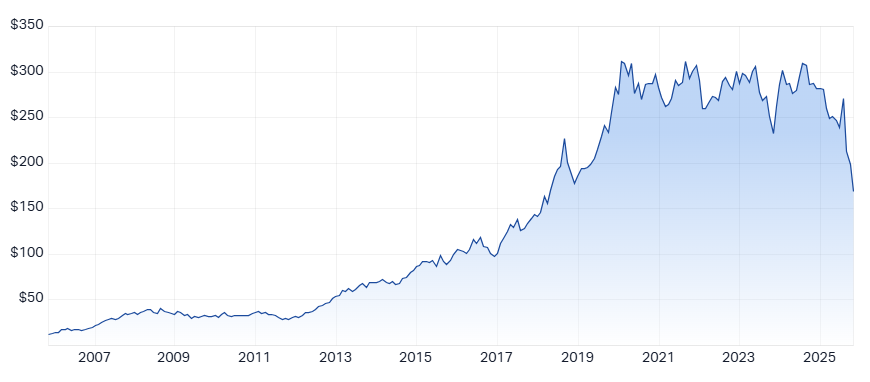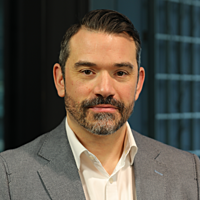What the heck is going on with CSL?
CSL Limited (ASX: CSL) has long been the darling of Australian investors. For the best part of a decade, the company was voted the #1 growth stock by Livewire readers in our annual Outlook Series survey. For years, it lived up to the hype, thanks to visionary management and relentless innovation.
Founded in 1916 as Commonwealth Serum Laboratories, it pioneered insulin production, vaccines and antivenoms in Australia. After privatisation in 1994, it embarked on a growth spree, buying Swiss ZLB (2000), Aventis Behring (2004) and, most recently, iron therapy specialist Vifor (2021). By 2025, it had US$15.6 billion in annual revenue and 29,000+ staff worldwide, earning a reputation for patient-focused R&D and reliable execution.
Analysts even called it “the market’s most reliable defensive stock". But even titans can fall, and cracks began to appear.
The COVID‑19 pandemic strained its plasma supply chain: lockdowns and border bans meant donors stayed away. CSL’s CEO admitted plasma collections “dropped significantly” in early 2020 before recovering as restrictions eased. Industry analysts note that border closures “caused a steep drop in plasma supply” in 2020–21. This scarcity of raw plasma, the lifeblood of CSL’s therapies, put pressure on volumes and margins.
Meanwhile, new competition and technology are emerging. Tender losses in its immunoglobulin franchises (in the UK and Mexico) suggest rivals are cutting into market share. And novel treatments, such as gene therapies for haemophilia, hint at longer-term threats.
On top of this, vaccine sales are weakening, with many Americans opting out of flu shots. In its latest half, CSL reported that Seqirus (the flu vaccine unit) was “negatively impacted by significantly low influenza immunisation rates, particularly in the United States”. US policy shifts under vaccine-sceptic leadership (e.g., RFK Jr. cutting CDC funding) have already led to a significant decline in vaccine demand, with more pain likely to come.
Mixed results, savage reaction, in August 2025
CSL’s FY25 results (announced 19 August 2025) were mixed. Sales grew about 5% to US$15.6 billion (just shy of estimates) and NPAT rose ~17% to US$3 billion. On the bright side, its core CSL Behring division - plasma‑derived therapies for bleeding and immune diseases - saw ~10% revenue growth, especially from immunoglobulins.
But investors focused on the shortfalls and warnings: revenue and EBIT slightly missed forecasts. CSL hiked its full-year dividend by ~11%, but launched a A$750 million buyback and announced a 15% cut to its workforce (3,000 jobs) to simplify operations.
The guidance was equally sobering. Management forecast only ~4–5% sales growth in FY26 (constant currency) and NPATA up 7–10% (to ~US$3.45–3.55 billion). Analysts had been modelling ~7–15% NPATA growth, so the new targets were materially lower.
The market’s reaction was brutal: CSL stock plunged roughly 16% on the day of the results, one of its steepest ever single-day declines.
AGM update (Oct 2025): guidance slashed
At the Oct 28 AGM, CSL’s management delivered another shock. CEO Paul McKenzie bluntly slashed guidance for FY26 and beyond. The new outlook: revenue growth only ~2–3% next year (down from 4–5%) and NPATA up just 4–7% (down from 7–10%).
CSL even warned that FY27–28 earnings would be “high single digits”, reflecting uncertainty from falling vaccine demand. Explaining the cut, CSL noted US flu shot rates would likely drop ~12% (overall) and ~14% in the 65+ age group. Chairman Brian McNamee called the collapse in US vaccination “remarkable”.
The outcome? Shares skidded again (down ~16% on 28 October) to a seven-year low. The share price is now down ~40% in 2025, trading near levels not seen since mid-2019.
In sum, two big downgrades in ten weeks have destroyed confidence in what was once the market’s most reliable defensive stock.

CSL 20-year chart. Source: Market Index
The selloff reflects deeper uncertainty. Analysts note that some of CSL’s recent issues were known (such as the large FY2026 restructuring announced in August), but the timing and severity of the new vaccine/competition problems caught markets off guard.
McNamee even told shareholders that the business had grown “too complex” and needed urgent simplification. The planned spin-out of Seqirus (the vaccine arm) was postponed due to “volatile” US flu markets that could undermine its value. Shareholder revolt is also brewing, with 42% of votes opposing CSL’s remuneration report at the AGM, reflecting investor discontent (a so-called “second strike”).
Whilst many fund managers have remained bullish on CSL through the volatility, a few have been more cautious. Yarra Capital Management's Marcus Ryan was recently on Buy Hold Sell, acknowledging that the CSL of today is not the same as the CSL of yesteryear.
Speaking with Ryan this morning, he reiterated the key question regarding CSL: "What is the medium to longer-term earnings growth for the business?"
"That's part of what we saw a recalibration on yesterday. The significant news was that the company is now acknowledging it may no longer be a double-digit earnings growth company in the environment it now finds itself in, but as we look out three years, we're now talking about a high single-digit earnings growth company.
Ryan went on to add that after the 16% fall yesterday, plus another 4% decline today, "the risk/reward overall is starting to look more balanced at these levels, with the stock trading on around 17 times consensus earnings.
That said, there are numerous important considerations still on Ryan's mind, as the business continues to face challenges across its core businesses. Indeed, both Ryan and other institutional investors eagerly await next week’s CSL Capital Markets Day in the USA for further insights into how the markets in which CSL operates are evolving.
"The challenges are not just confined to this fiscal year, and we'd call out the two particular areas yesterday that were cited", says Ryan
"One was around their core business of Behring, the blood plasma business. It's about 70% of sales, and notwithstanding solid underlying demand growth for many of CSL’s leading blood plasma products, we still see pockets of competition and substitute product risk there.
"The second and less surprising driver of the downgrade was the flu vaccine business, Seqirus. It's about 10 to 15% of sales, and end market weakness is really driving that. It’s difficult to see what swings this abruptly positive in F27 given current US healthcare settings. “
Ryan concluded by saying that he's not convinced that some of the issues noted above are confined just to FY26, "therefore, there is still a degree of earnings risk as we seek to look further forward to F27 and F28."
"Beyond that, it's hard to call yesterday's AGM update “the bottom.” But what we do acknowledge is that the company is being a bit more proactive to recalibrate earnings".
Marcus Today's Henry Jennings is equally cautious, noting that there appears to be a sense of panic around the company.
He points out that the Seqirus demerger came out of the blue, only to be pushed back - as noted above. As for the vaccine situation in the US, Jennings can't see any immediate relief there either.
"Given that Trump has three more years and assuming the RFK Jr. is still in the health gig, it seems unlikely that it will get any relief from the US on vaccines. There appears to be no real catalyst, with three more years of this US administration, to negotiate", says Jennings.
Jennings' suggested course of action? He believes the company could be well served by refreshing the board and management, with the second strike highlighting that change is required. Otherwise, he contends, that sense of panic noted earlier could lead to more bad decisions - like another acquisition.
As for the business's fortunes and the share price, Jennings suggests a slow decline is more likely than a turnaround.
Elston Asset Management’s Andrew McKie also sees CSL facing a tough near-term path, but believes the long-term value remains intact for those investors willing to be patient. He notes that while the core plasma business isn’t back to “that high single digits, low double digits” growth yet, “the underlying demand for core IG (immunoglobulin) is there and driven by population growth around the globe.” He sees this normalising through calendar 2026.
McKie points out that Seqirus was clearly the main culprit in the latest downgrade, with US vaccination weakness pushing performance “from high single-digit declines to mid-teens.” However, he believes “the balance of the business is not operating too badly,” suggesting the core isn’t broken, just under pressure.
He stresses that successful execution is key from here: CSL needs to trim costs in its plasma collection business, make good on headcount reductions, and shift R&D spend toward more advanced external tech.
“Given the number of items that they have to work through, you would expect that it will be quite difficult to execute on all those with perfection,” he cautions.
Still, McKie believes the long-term investment case remains strong: “If you’re on a longer timeframe, there’s clearly value now in one of Australia’s highest quality businesses.”
Not all bad news...
It wasn't all bad news when canvassing the troops for comments on CSL. Whilst many managers who have remained steadfastly bullish were understandably sheepish about doubling down on the record, one value manager didn't want to comment because they were busy buying.
That's right, they were using the second big share price slump in three months to load up at what they see as a compelling price for one of Australia's greatest corporate success stories.
Time will tell if they're right.
Over to you...
3 topics
1 stock mentioned
3 contributors mentioned

